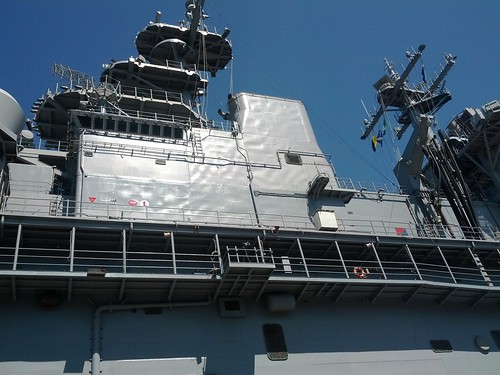While waiting in line I took this photo of the superstructure of the USS Wasp. Note the 'wrinkled' appearance of the plate. One might ask how is extremely strong plate wrinkled? Here's a hint: that didn't happen from wear and tear; the USS Wasp left the shipyard looking like that.
In the old days of battleships, the Navy never had this problem. 12" of battleship armor doesn't like deforming. Now, the Navy has shifted to using very thin, very strong steels. 90% of plate steel used in modern Navy shipyards is 10mm thick or less. The plate is extremely strong; old steel might only be 30-ksi, while modern steels (like HSLA) are 100-ksi. The Navy has been using these high yield steels since the early Nimitz-class carriers.
How can you work these high strength steels into the curves and complex geometry of a ship? Well, not with bending. They are too strong and you'll either need too much force or you'll deform the steel. On the other hand, if you use the steel's own properties against itself, you can easily deform it. All materials are subject to thermal expansion. If you heat up the steel enough in just the right way, you can induce the curves that are present in the hull of a ship.
Why is the photo wrinkled? Well, how do you put a modern naval ship together: Welding, a thermal process. The deformation is from welding. The Navy has also been tearing their hair out trying to resolve these wrinkles for the past 20 years. There are all sorts of reasons the Navy is concerned, but one big one is radar signature. The curves reflect radar waves extremely well and make the Wasp look like, well, an aircraft carrier on radar. It makes it extremely easy for an Exocet to home in...
Solving this problem is a hot research area. UNO happens to be at the forefront of a lot of this research.

trey cool
ReplyDelete